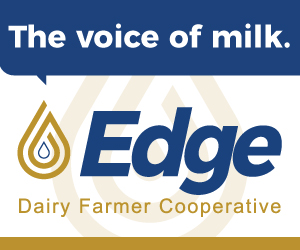This is the fourth podcast in our five-part series examining a wide range of issues facing the dairy industry sponsored by Edge Dairy Farmer Cooperative. In this episode, Spencer Chase and Ben Nuelle explore the realities of how hard it can be to secure a reliable workforce for the nation's dairy farms, what that means to the producer, and what is being done about it on Capitol Hill.
To listen to this podcast and other episodes in the series, click here.
You can also subscribe to the podcast on iTunes, Spotify, and Google Podcasts.
Milking cows is tough work. You have to wake up well before the sun rises and your day ends well after it sets. Most cows are milked two if not three times per day. Between milking comes chores and then back to the parlor for night milking. And don’t forget about the extra chores during harvest, as most dairymen grow their own crops for feed. If you ask any farmer who’s milked cows for the last few decades they’ll tell you there’s no rest for the weary. The job is labor intensive, so who is going to milk those cows?
Migrant workers or fancy robotic milking machines? Both have their prospective policy and economic hurdles. Larger dairy operations rely on farmworkers to help with chores and milking but immigration has become a divisive topic in Congress these days as simply passing an agriculture labor bill can be a steep mountain to climb. Robotic milking machines sound like a decent alternative but most cost millions of dollars. In this episode, we’ll explore how dairy operations are pushing for legislation to reform the H-2A visa program, a seasonal program for temporary guest workers as well as what they feel the future holds as the next generation enters the family business.
We’ll look into that and much more on Agri-Pulse Deep Dive on Dairy, Episode Four: Help Wanted.
Labor might be the most frequently-discussed problem facing the dairy industry. It’s not the kind of topic that ebbs and flows with the markets or consumer preference, it’s not something that’s necessarily due to the policy of any one particular party. It’s a constant. It’s been a persistent issue for years. And even the victories in the issue, however few and far between they might be, haven’t been able to overcome the stiff roadblocks that have plagued the discussion.
But before we get too deep into the issue, before we talk legislation and regulation and administration, we need to explain just what it is we’re talking about.
There’s a few reasons why labor is such a big problem for the dairy industry.
First of all, the work is constant. Dairy cattle need to be milked multiple times per day every day of the year. Rain or shine, hot or cold, weekday or weekend, it doesn’t matter. That means the dairy industry doesn’t fit in temporary programs like the H-2A visa program. More on that later. But the constant flow of milk can only remain constant if workers are there to do the job.
That’s another thing, there’s a lot of jobs to do. There’s feeding, there’s trucking, there’s animal care, there’s the toughest job of all: milking.
It’s a little different on every farm. And I stopped by one farm in particular to see for myself.
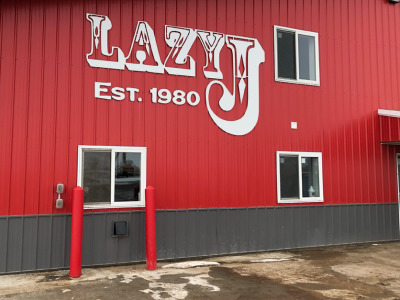
Lazy J Dairy, Wolsey, S.D.
Lazy J Dairy has been operating near Wolsey, S.D., since 1980. Today, Russell and Janet Jungemann run the dairy with their son Lucas and his wife Kari. They’ll milk about 900 cows there on a daily basis in a facility that’s about two years old. There’s two rows of milkers, 16 on each side, and the entire time I was there, there was a constant flow of holsteins coming through the parlor. They milk around the clock in the parlor, stopping twice a day for cleaning.
There’s two workers keeping the milk flowing today. The cows come in, their udders are cleaned, and then the milker gets to work. Workers walk down the rows of cattle and place milkers on each cow. From there, the milk is pulled through piping into a lower room, creating a galloping sound as the milk makes it way to the bulk tank.
All this noise and commotion brings us to our second point: the work is hard.
The work is tedious, it’s intensive, and it’s hard.
It’s work that can be difficult to do and requires a motivated employee. Something that can be hard to find.
Allow me to introduce you to two dairy farmers.
Blake Alexandre is an organic dairy, egg, and beef farmer in Northwestern California near the Pacific Ocean on one side and the Oregon border on the other. His operation spans a few different locations with 4,000 milk cows and about 50,000 laying hens. At any given point, his workforce of about 140 people includes mechanics, truckers, bookkeepers, and more to keep the wheels of the operation turning.
And sometimes, it’s tough to keep some of those workers around.
“The schedules are long and the work is consistent. It’s somewhat hard, it’s a little dirty, and so most locals don’t want that kind of job. They don’t really want to work, they don’t want the commitment where they have to be hooked up and engaged in their job — whatever it is — 50 minutes an hour. They get breaks, they get lunch, everything they’re supposed to get. It’s not like we’re asking them to over and above break rules or anything, we’re just talking about doing the job. And it’s a lot of work, so locals don’t want that work. They think they do; they come out, they work a week, and then they quit.”
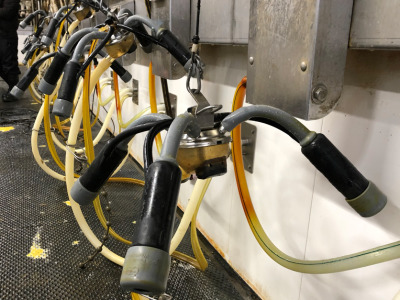
The milkers at Lazy J Dairy include automatic shutoffs that detach when milking is complete.
Blake’s dairy farm, like hundreds of other dairy farms around the country, is heavily reliant on a Hispanic workforce to get things done. So is Pat Lunemann’s.
Pat is a dairy farmer from central Minnesota. Like most good Minnesotans, he can tell you the location of his place using a few different qualifiers, last of which would be where they are in relation to the Twin Cities. (It’s about 150 miles to the northwest, if you were curious.)
On his farm, there’s about 20 employees working to care for about 850 dairy cattle, about 900 young stock that will be farm’s dairy cattle in a few years, and a farm of about 1,600 acres. There’s a few guys who used to have their own dairy operation that come in for work every day. But in the milking parlors, workers from Mexico, Central America, and a few other various parts of the world can be seen on the job on a daily basis.
To be clear, it’s not like there’s no available workers in the American labor pool, Pat says it’s just that there’s a need to expand that pool a little to find what the job requires.
“I use the phrase that the willing and able are already working, and we have such a low unemployment level in the United States that people who really want a job already have a job. So there just aren’t people out there who want to do farm work, at least not around me. And as I talk to other farmers around the country, it’s pretty much that way everywhere across the United States; the willing and able are already working. So to find somebody that’s willing to work on your farm, you have to be open to looking at people with different backgrounds. Whoever’s willing to take good care of cows and show up every day and not have excuses, we’re willing to take a look at.”
When workers decide ag labor just isn’t for them, it’s not like the cows will take the day off as a courtesy. There’s still work to be done, so Blake says they make a point of cross-training employees to keep things running as close to normal as possible.
Pat says right now, his operation is in a good place with their labor needs. But he also says that can change in a hurry.
“There are times where we are really short and it’s all hands on deck to make sure that we have the shifts covered. We’ll be OK for a while and then one or two people leave to pursue a different job opportunity. It’s really tough because the cows have to be milked. You can’t just shut down the operation, and that’s what’s so frustrating with the lack of available labor is that we have to operate and there aren’t a whole lot of backup systems that we have.”
All the labor issues are compounded by the fact that farmers are at their wits end about just what they’re going to do to keep their milkers running.
Because financially, they can only do so much. Both Blake and Pat told me they’re paying their workers well above minimum wage. There’s also housing and other benefits too. For Blake, the compensation package is stretched about as far as it can be.
“We can’t afford to always pay more or give away more or whatever. That does not work because it’s hard to pay our bills right now as a dairy farmer, and we’ve been in this mode for about three or four years of declining prices at the farm where a third of our milk income has gone away, and yet our costs have gone up. It’s really really difficult to continue. So we can’t just keep paying more. Eventually we run out of money and so that’s the danger there. So we’ve got to motivate through being a good workplace and we do as much as we can through our meat, milk, and eggs, giving it away or providing it extra cheap or mostly free. And then a few other benefits like a health program and a paid leave per year. Obviously making the job easier and paying more all the time and that builds employee morale and ultimately consistency and long term-ness with all employees, and that’s huge and that’s worth a lot. We can’t always afford it.”
With soaring costs of labor, feed, all kinds of inputs necessary on a dairy farm, efficiencies have to be found somewhere. And sometimes, as Blake tells us, the improvement is known, but out of reach.
“We’ve got older parlors. Our newest one is about 40 years old. We’ve done remodels and upgrades to the take-offs — the machines that actually milk the cow and come off automatically — we’ve upgraded all that stuff. All in all what we really need is a different style of milking parlor like a carousel where the cows are spinning around at a slow rate. It takes two people to run those and they can milk 400 cows an hour fairly comfortably. We’re working with more people and about half the number of cows per hour. There’s a lot of room for improvement there that just can’t afford to do because it would take a really large investment to build an entirely new milking barn.”
If you aren’t familiar with rotating milking parlors, do yourself a favor sometime and look them up online. Seeing a video of one in action is really something. It’s a fascinating achievement of efficiency, technology, and animal welfare.
And it’s an achievement that doesn’t come cheap.
“It’s a function of being able to get a loan to spend, say, five or six million dollars on a large facility that would milk half of our cows with two people. It’s the loan or having the cash flow to support the loan or cash literally to pay for it. Right now, we don’t have either one of those three. Nothing."
The upgrade costs could be a little cheaper if you didn’t need to build a new facility to go along with the new parlor and could just use an existing building. But no matter how you slice it, that’s a major investment that doesn’t always pencil out, even with the resulting savings in labor costs.
The constant issue of labor availability isn’t new; it’s been going on for years. The issue isn’t really a secret either; it’s a popular campaign talking point for both parties seeking to score support among rural voters. It isn’t just an issue for the dairy industry either, there’s plenty of other labor-intensive tasks in agriculture that need the help of workers born outside the United States. There is a program for ag workers. It’s called the H-2A visa program. It’s designed for work that is seasonal and temporary that might not have a lot of interest among the domestic workforce. Sounds like a fit for the dairy industry, until you remember one thing: the program is seasonal, the work is not.
H-2A visas are common in things like the produce industry, where a rush to harvest labor-intensive crops requires an all-hands-on-deck mentality for a short period of time.
Ben’s going to talk more about some of the legislative efforts on farm labor in a little bit, but make no mistake, those efforts are out there. Pat has been a part of many trips to Washington to lobby on the issue through some producer groups he’s a part of. He’s not alone in those efforts, and he and his fellow producers want to see something get done.
“We need to do something for the 11 million people that are here illegally. We need to decide what we’re going to do there, but then we also need to create a visa system that brings us labor that meets our needs. We can’t be struggling to find labor all the time, otherwise we’ll have difficulty putting food on the plates of the common American citizen.”
One path might be to tweak the H-2A program.
“That would be a tremendous help because the current H-2A system is for seasonal labor only. Dairy and livestock in general is a year round business, so the H-2A program does not fit the needs of livestock producers in the United States, so we definitely need a fix in the H-2A program or a visa that’s similar to what our needs are.”
We’ve seen progress on the subject before. Bills have been introduced, heck some of them have even passed one chamber of Congress. But dairy farmers across the country are still waiting for something to get to the president’s desk.
And Blake and many others are frustrated.
“The Republicans blaming the Democrats and the Democrats blaming the Republicans, and it just keeps flipping back and forth. They really have the same policy on illegal immigration; talk about it during elections and then do nothing about it. I would like to see us literally do something about it.”
He’s far from alone on that point. The need for ag labor reform has been a hot-button issue on Capitol Hill for years, as Ben tells us after this.
Agri-Pulse Deep Dive is brought to you by Edge Dairy Farmer Cooperative — the voice of milk. Edge provides dairy farmers across the Midwest with a strong voice — the voice of milk — in Congress, with customers and within communities. Edge is an energetic, forward-thinking organization that represents all dairy farmers equally, recognizing both their differences and similarities. As one of the top dairy cooperatives based on milk volume, Edge amplifies the voice of farmers. Now, more than ever, dairy farmers need to be heard. Join us at VoiceofMilk.com.
Fixing the nation’s immigration system has long been a battle to get both Democrats and Republicans on Capitol Hill to agree on a piece of legislation. It is a difficult process because Democrats won’t go for immigration reforms without giving undocumented immigrants amnesty and Republicans won’t move forward unless immigrants go through the process legally. The House recently passed a bipartisan bill to reform ag labor which would expand the H-2A visa program to year-round farmworkers and provide growers relief from wage hikes. This bill, known as the Farm Workforce Modernization Act, provides some prime examples of why immigration legislation doesn’t usually get done because politics always seem to get in the way.
During the House Judiciary Committee markup of the bill, immigration hard-liner Republican Doug Collins of Georgia took every chance he got to point out the elephant in the room: legalization of undocumented farmworkers.
“Moving forward, I am as soft as a no as I can be on this. I am not lighting my hair on fire on this one. The reality of what this bill does is found in the first section and that is the part that, by the way is not going to get a lot of talk in this committee but the minute it gets out of this committee, the pathways and the legalizations and amnesty will get a lot of attention. OK, we just have to acknowledge that.”
He even went as far to call out the dairy industry for supporting the bill.
“H-2A users asked for no cap on the program. Where H.R. 5038 does provide some visas for year-round work, it caps the number initially of 20,000 per year and then reserves half of those for dairy. If you’re here from dairy and you had lobbied for the help of dairy, congratulations. Y'all have done a great job. You need a raise because you succeeded wildly in this.”
Subcommittee Chair on Immigration and Citizenship, Republican Ken Buck of Colorado, agreed with Collins saying the bill did nothing more than to provide massive amnesty.
“First this bill opens the door to a massive amnesty. We’re bringing a bill to markup without even the slightest idea of how many individuals would put on a pathway to citizenship.”
Democrat Zoe Lofgren of California introduced the bill with Republican Congressman Dan Newhouse of Washington state. While she acknowledges her district doesn’t have that much agriculture in it, she understands access to labor has been an ongoing challenge for farmers throughout the years. Lofgren remembers dealing with this issue during that last Congress and notes people need to understand farmworkers are needed to fill jobs in the agricultural industry, whether it is dairy or other occupations.
“I remember when I chaired the immigration subcommittee the last time, I had the then president of the Southern Baptists Convention. He said for years we had two signs at the southern border, one sign said no trespassing and the other sign said help wanted. I think there is some truth to it. People came across and filled needs that we had in our economy and agriculture is a very good example and there was a circularity to it. People would come. They would work they would go back, well after 9/11 the border got tightened up, and rightfully so, but people were stranded over of this side of the border. They couldn’t go back and forth as before. There was no program that really worked very well for visas, so people have been here working. We know from some of the analysis that a majority of the undocumented farmworkers for example have been here more than ten years. A majority of them have family here. I mean they live here, and they are not going anywhere and if they did, it would be a real blow to the ag economy.”
So there’s two overarching problems with immigration reform. One, is Congress can’t agree on legalizing undocumented workers and the other, is once you fix one sector of labor, say agriculture for example, other groups outside of ag want to see improvements in their industries as well. Sen. Chuck Grassley of Iowa, is currently the Chair of the Senate Finance Committee, but he’s also been at the helm of the Senate Judiciary Committee, which has jurisdiction over immigration policy. He says both chambers have even tried to make ag labor and immigration reforms through appropriations bills.
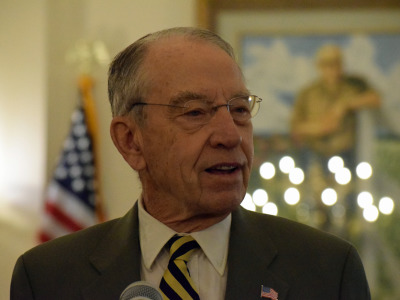
Sen. Chuck Grassley, R-Iowa
"Sometimes we’ve worked out for H2 people to come to the country to satisfy some parts of agriculture and then you get to getting it into the final appropriation bill, end of the year appropriation bill, and at that point the two Republican leaders of the two houses and the two minority leaders, and Pelosi would be one of these four people, they can keep anything out. We’ve worked out compromises to get more agriculture labor and then it doesn’t get into the final product.”
Party differences also doomed a comprehensive immigration bill developed by a bipartisan “Gang of Eight” senators in 2013. The legislation passed the Democratic-controlled Senate, 68 to 32, when 14 Republicans joined the Democratic majority in supporting the measure. But the bill later died because the Republican-controlled House wouldn’t put it to a vote. There was too much internal GOP opposition. Had it been enacted, the bill would have made it possible for many undocumented immigrants to gain legal status and eventually citizenship. It would have also increased border security by adding up to 40,000 border patrol agents. But there are not just disagreements between Democrats and Republicans, there can even be disagreements within parties. Some view the comprehensive approach is the right way where others feel a measured approach is better. Sen. Thom Tillis, a Republican from North Carolina who is a leader on ag labor issues, says you can’t pass immigration reform without it being comprehensive. But Congressman Ted Yoho of Florida, has a different view.
“We can look back at the last 36 years when they’ve tried to start off with something and it builds and becomes comprehensive. I’ve learned that in Washington the word comprehensive before any bill is a death sentence because it becomes so bogged down with all of this. Keep it purity of purpose. We need guest workers in this program, I mean in this country, we need strong labor but yet we need a steady supply for our producers. I had one of the producers when we were doing our ag tour he says, ‘the bottom line is this. We are either going to import our labor or we are going to import our food.’”
These are just a few examples of how immigration reforms stall in Congress but some in the agriculture sector are still optimistic something will get done.
Chuck Conner is President and CEO of the National Council of Farmer Cooperatives. Established in 1929, NCFC consists of nearly 2,500 local farmer cooperatives across the country. A cooperative is a group of farmers marketing their products or buying supplies. Conner served as Deputy Secretary of Agriculture from May 2005 to 2007 and then became Acting Secretary from 2007 to 2008 when then Secretary of Agriculture Mike Johanns resigned. Conner has decades of national and state government, agricultural and trade association experience under his belt. I sat down with him to talk about why dairy operations so badly need migrant workers.
“There are no temporary workers coming through our H-2A program coming to our dairy farms. Under current law, that is illegal because it has to be seasonal work. Obviously, dairy farming is 24/7. It is the opposite of seasonal work. It never stops. The workers that we do have on our farms and ranches today that are Mexican or of Latin decent, many of them, they are people who are not generally coming and going. They have been her for a very very long time, even though they may not have proper documentation. So that is why in our immigration debate, there are two elements of the debate that are important. Obviously, we need to reform our guest worker program — make it available for year around work as well, but we have estimates of over a million workers, many of them on our dairy farms who are already on our dairy farms and they are not coming and going. They have been in the United States residing, in some cases, for decades but they don’t have proper legal status.”
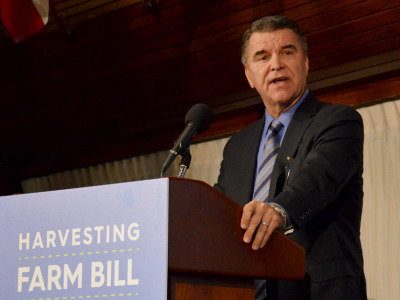
Chuck Conner, NCFC
Conner says while there are many different paths to fix the ag labor problem and immigration in this country, he has one reminder as talks continue.
“Many people out there believe that they know the dairy farmers have got to hire labor. They know they need help to run 24/7 operations beyond just their family like it used to be. But they still have that notion that dairy farmers could hire U.S. citizens and Americans to do that work for them and they don’t yet realize that, that is not the case and that we do need migrant immigrant labor in order to function in these dairy operations today. That is where our work on immigration comes into play so importantly on our dairy farms.”
Despite partisan politics in Washington, Conner feels confident something on immigration or ag labor reform can get done in the future and even this year. He argues whether it’s dairy or whether its fruits and vegetables, or whatever commodity, American agriculture is unified in saying something needs to be done and the problem needs to be fixed soon. Join us next week for the final episode as we look at what dairy producers are doing to meet environmental sustainability goals on their farms. Agri-Pulse Deep Dive is sponsored by Edge Dairy Farmer Cooperative, the voice of milk. For Spencer Chase, I’m Ben Nuelle.
For more news, go to www.Agri-Pulse.com.


